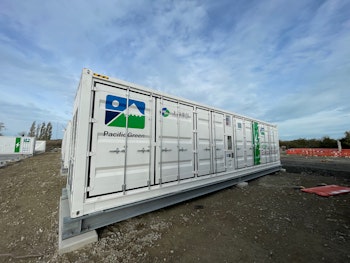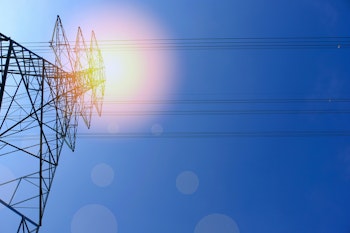
Australia has a special place in the annals of large-scale battery storage. In November 2017, the nation became home to the first 100 MW battery system in the world.
The Hornsdale Power Reserve, with 129 MWh of energy capacity, saved South Australian consumers more than AUD$150 million in its first two years of operation and had a 50 MW, 64.5 MWh expansion in September 2020.
In the last half decade, the US has overtaken Australia as the home of the world’s biggest batteries, although there is still one Australian project, Neoen’s 300 MW, 450 MWh Victorian Big Battery near Geelong, in the top five.
Despite this, there are more reasons than ever to invest in megawatt-scale battery storage in Australia. And the 10 applications that follow are not mutually exclusive, so companies funding a project for a given battery use case could easily make money from other uses.
Ancillary services
The Australian grid has historically been prone to frequency control problems, and electricity networks generally have a hard time adapting to a growing share of intermittent renewables in the energy system.
Because large-scale battery systems are good at providing ancillary services such as frequency response and voltage control, it is a safe bet they will be able to make money in the Australian market—particularly with the impending closure of thermal plants such as the Eraring power station.
Load shifting
In South Australia, the largest source of energy generation now comes from rooftop solar. This means the grid gets overloaded with renewable energy at midday and suffers from a deficit at nighttime.
The best way to address this issue is by installing big batteries, either alongside new utility-scale wind farms or near substations that are likely to be most affected by the changing profile of energy generation in the state. And it’s not just South Australia that this applies to—other states see it too.

Grid resilience
Weather-related disasters have more than doubled in Australia since the 1970s, topping AUD$35 billion in damages in the decade up to 2019, according to Australian non-profit the Climate Council. This is stressing the grid and increasingly causing blackouts.
One way to keep the lights on is to install big batteries at critical substations, so local communities can survive off battery power in the event of a blackout.
Transmission reinforcement
Parts of the Australian grid face transmission constraints caused by a lack of high-voltage power lines. This is a common problem in many grids and one that can take a lot of time and money to fix. Electricity network upgrades are costly and can be subject to permitting challenges.
But an easy way to fix the problem is by installing a battery next to any potential bottleneck. Thus, if there is an electricity shortfall then the battery can make up the difference, avoiding stresses on the grid.
Power firming
Even when electricity supplies are available, the creaky nature of some parts the Australian grid might mean it makes sense to install battery systems for improved power supplies.
Operations such as data centers need good-quality power supplies, which can be achieve by using a battery to smooth out fluctuations in frequency and voltage.
Backup power
For operations that absolutely must stay online all the time—not just data centers but also hospitals, for example—then a big battery can serve as an important source of backup power in the face of growing high-impact weather events and potential blackouts.
Having a big battery sitting idle most of the time may not make a lot of financial sense but here the battery’s versatility can come into play, allowing the asset owner to make revenues from grid services or save energy by improving solar self-consumption, for instance.

Energy aggregation
As Australia gets rid of its coal-fired power plants, it faces a lack of dispatchable power assets that can kick in to deliver energy wherever and whenever needed. To overcome this problem, developers are tying distributed generation sources together to form virtual power plants.
In a virtual power plant, hundreds or thousands of energy assets are controlled centrally so they act like a single large asset. But storage is key for dispatchability, which is why Australia’s growing virtual power plant market will have a growing need for big batteries.
Community microgrids
Remote Australian communities often find it hard to get a grid connection, to the point that power firms are increasingly looking to kick them off the electricity network. To make up for poor or absent grid supplies, these communities need renewable energy and batteries.
Having a microgrid also helps these communities deal with blackouts and extreme weather events, so the importance and scale of microgrids is likely to grow with increased impacts from climate change.
Off-grid industries
A big part of Australia’s wealth comes from mining and mineral extraction concessions far removed from human habitation. These energy-hungry industries have traditionally relied on fossil fuels for power, but that is changing as mining companies look to embrace sustainability and reduce costs.
These mining operations are increasingly turning to renewable energy sources such as wind and solar. For such energy sources to provide the round-the-clock power that mining companies need, the renewable generation assets need to be tied to battery systems.
Green hydrogen
While perhaps not a here-and-now opportunity, Australia has big plans to produce green hydrogen using renewable energy. The country is well placed to lead in the emerging global clean hydrogen market because of its abundant, low-cost renewable energy resources.
However, for maximum efficiency the electrolyzers used for hydrogen electrolysis need to run for as long as possible, which might be difficult using only intermittent wind and solar energy. Enter battery storage, an asset that can extend electrolyzer production times and improve hydrogen costs.
While Australia has plenty of opportunities for battery developers, one thing it lacks is companies with experience in installing and operating the plants.
At Pacific Green, we are working on major storage programs around the world and can work as engineering, procurement and construction partners or deliver according to a build-operate-transfer model. To find out more, speak to us now.
Publish date: 21 November, 2022